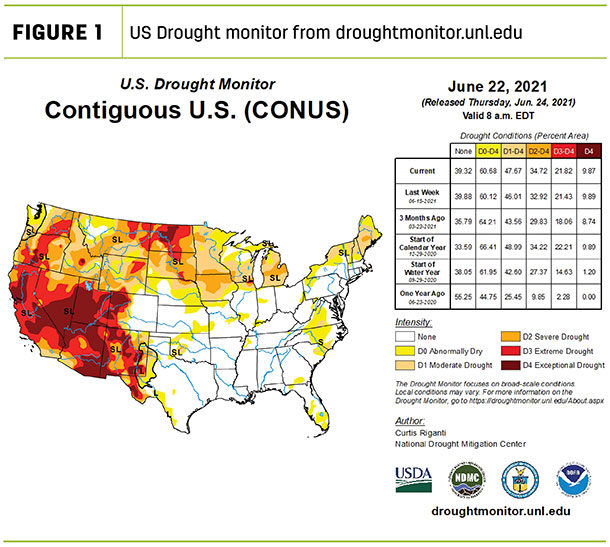Plant health plays a critical role in optimizing forage quality. Unfortunately, for much of the U.S., our crop growing season is already off to a challenging start.
Although severe drought conditions are impacting many crop and livestock producers, implementing certain management practices can help make the most of our forages. The latest drought update indicates that 47% of the continental U.S. is in drought stage, and 34% of the continental U.S. is likely to have persisting drought. Drought development is likely in an additional 9%. Tools such as the drought monitor (Figure 1) can be used to help understand and keep track of current drought conditions.
Severe and persistent drought conditions are expected to continue for much of the West, northern Central Plains and Upper Midwest in the U.S. Although the July climate prediction does not expect a drier-than-normal July, it does not expect a wetter July either. This coupled with the higher-than-normal temperatures for most of the U.S. may lead to further drought stress on already drought-stressed crops (Figure 2).

We are all familiar with the traditional visual symptoms of drought stress. The leaves begin to wilt or curl, and growth progression begins to slow – but what is happening below the surface and what does that mean for forage quality? Plants respond to different biotic and abiotic stressors in a variety of ways. In drought conditions, as water becomes limited in the soil, less water is transported up through the stem. This disrupts the plants’ ability to uptake and assimilate nutrients from the soil, resulting in a decrease of nutrients available for growth and cell reproduction. Small openings on the leaves, called stomata, remain closed to help prevent excess moisture loss from the leaves.
In combination with other stress responses, this action can have an impact on the amount and efficiency of photosynthetic activity – further decreasing plant growth. These stressors, along with many other complex stress pathways, can lead to large reduction in grain and forage yield as well as impacts on feed quality.
Forage quality
The impact of drought varies – depending on the crop and time of year the stress occurs. In alfalfa, drought can result in improved forage quality due to increased leaf-to-stem ratios; however, yield may be significantly reduced.
In corn plants, dry conditions during silking and tasseling can lead to reduced starch content of ensiled feed, which can reduce the overall energy content significantly. Limited research has been published examining the impact of drought on fiber quality and digestibility. Experiments conducted by the University of Wisconsin – Madison found numerically lower neutral detergent fiber (NDF) and higher starch when drought occurred prior to pollination but was followed by rains during grain fill stages.
This corn had slightly lower NDF digestibility (about 2%); however, because of the higher grain concentration in the crop, milk per ton was increased when the crop was harvested at the same maturity. When drought continued beyond pollination into grain fill stages, a reduction in starch was noted, along with a 3% to 8% decrease in estimated milk per ton. Regardless of the timing of drought, these studies reported a yield reduction in response to drought. Other studies have found that quality impacts due to drought stress can vary widely depending on crop hybrid.
Replant
In some circumstances where drought is exceptional, the crop cannot be salvaged and replant is the only option. Short growing season crops such as sorghum, sorghum-sudangrass or millet can provide a replant option that is more drought-tolerant than many traditional crops. It can be utilized in a variety of applications, providing not only tonnage but high-quality fiber. Although nitrates have been a common concern for these types of crops during drought conditions, harvesting and storing as silage will reduce nitrates by upward of 50%. Crops must be ensiled properly and completely to decrease the amount of nitrates present. However, it is still recommended to test for these compounds to ensure no issues will be incurred.
Plant health
Although drought can have severe consequences on plant and soil health, there are ways to alleviate some plant stress and promote healthy crops. Soil with higher organic matter typically has a higher water-holding capacity, which helps make the most of each rainfall event. Management practices that encourage high organic matter in soils can prove particularly beneficial in drought years. Because nutrient uptake via the soil may be impaired during times of drought, testing crop tissue to understand deficiency may expose opportunities to foliar feed these nutrients where they can be absorbed via the tissue instead of relying on soil moisture for uptake. Working with an agronomist can highlight management strategies to help alleviate some of this stress and make the most of your forage crop.
Disease pressure
Hot, dry years present a high risk for Aspergillus infestation in crops. These fungi can produce many toxins, including aflatoxins. Aflatoxins are a major concern as they can be carried over into milk, and FDA restrictions limit the amount of aflatoxin (M1) that can be present in milk. In a year when forage inventory may be impacted by drought, aflatoxin contamination can limit the inclusion of these feeds in a ration, further stressing feed availability.
Use of fungicides can help to decrease the risk of fungal disease. Some fungicides have shown beneficial impacts on plant health even when disease was not present. These plant health benefits can also lead to an increase in forage quality and milk production potential. For areas seeing above normal rainfall and moderate temperatures, fungi from the Fusarium spp. may be a larger concern. These fungi can produce a variety of different mycotoxins including deoxynivalenol, zearalenone, T-2, HT-2. These fungal infestations cause added oxidative stress to the plant and rob valuable nutrients (Table 1).

Harvest considerations
In order to increase silage tonnage, many producers may consider cutting plants lower to harvest more of the plant material. Keep in mind that ash contamination may increase as plants are cut lower. In addition, lower parts of the stem are typically less digestible, which can dilute the energy content of the silage. More tonnage removed from the field may also lead to increased nutrient requirements for the upcoming crop year.
A majority of the growing season still remains, and conditions can change rapidly. Regardless of the environmental factors we cannot change, management practices can help us make the most of whatever the season may bring. Understanding the risks of environmental impacts on crop quality and disease pressure may also help us make better decisions on how to best utilize the feeds available.
References omitted but are available upon request by sending an email to the editor.










